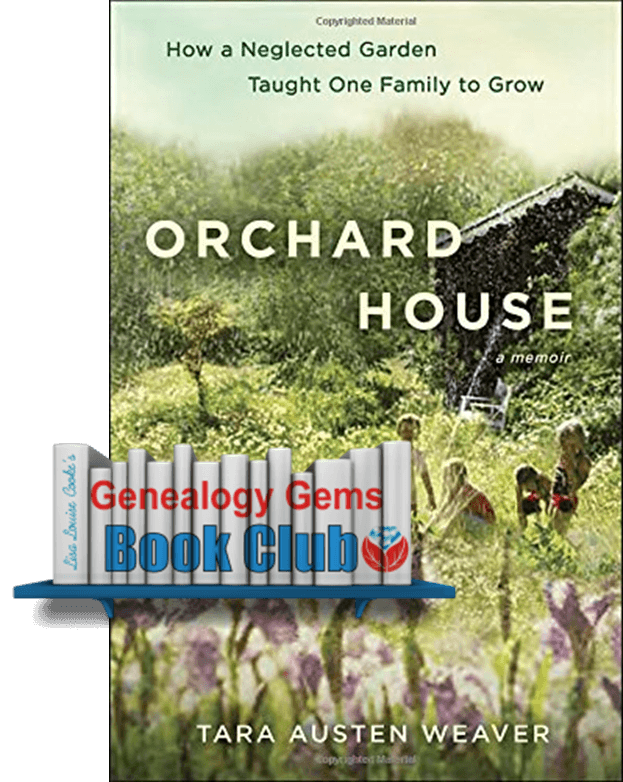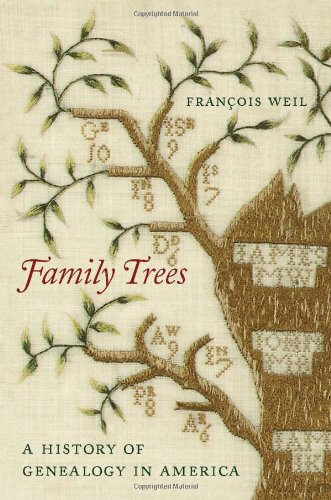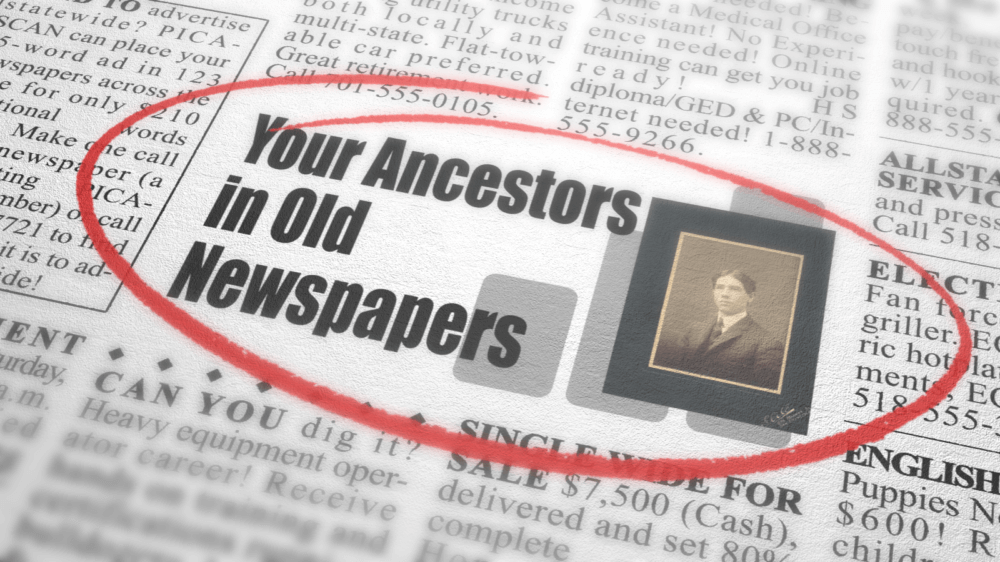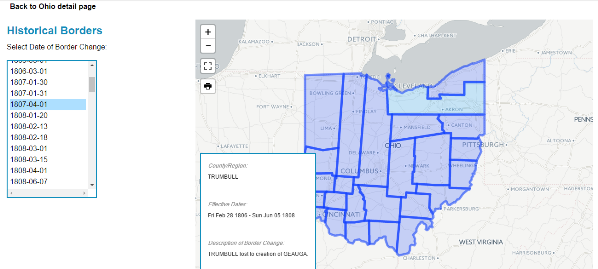by Lisa Cooke | Jan 14, 2016 | 01 What's New, Book Club
The first Genealogy Gems Book Club featured selection for 2016 has been announced. It’s a mouthwatering memoir of food and family. Check it out! 
The newest Genealogy Gems Book Club selection was just announced in the Genealogy Gems Podcast Episode 187! The new title is Orchard House: How a Neglected Garden Taught One Family to Grow by Tara Austin Weaver.
by Tara Austin Weaver.
 Tara is most famous as the author of Tea & Cookies, recognized as one of the top 50 food blogs in the world. Orchard House is her recently-published memoir. Tara’s recipe for Orchard House is one part food, one part gardening and two parts family drama, liberally seasoned with humor and introspection. The “book jacket” summary from the publishers describes it this way:
Tara is most famous as the author of Tea & Cookies, recognized as one of the top 50 food blogs in the world. Orchard House is her recently-published memoir. Tara’s recipe for Orchard House is one part food, one part gardening and two parts family drama, liberally seasoned with humor and introspection. The “book jacket” summary from the publishers describes it this way:

 “Peeling paint, stained floors, vine-covered windows, a neglected and wild garden—Tara can’t get the Seattle real estate listing out of her head. Any sane person would see the abandoned property for what it was: a ramshackle half-acre filled with dead grass, blackberry vines, and trouble. But Tara sees potential and promise—not only for the edible bounty the garden could yield for her family, but for the personal renewal she and her mother might reap along the way.
“Peeling paint, stained floors, vine-covered windows, a neglected and wild garden—Tara can’t get the Seattle real estate listing out of her head. Any sane person would see the abandoned property for what it was: a ramshackle half-acre filled with dead grass, blackberry vines, and trouble. But Tara sees potential and promise—not only for the edible bounty the garden could yield for her family, but for the personal renewal she and her mother might reap along the way.
So begins Orchard House, a story of rehabilitation and cultivation—of land and soul. Through bleak winters, springs that sputter with rain and cold, golden days of summer, and autumns full of apples, pears, and pumpkins, this evocative memoir recounts the Weavers’ trials and triumphs, what grew and what didn’t, the obstacles overcome and the lessons learned. Inexorably, as mother and daughter tend this wild patch and the fruits of their labor begin to flourish, green shoots of hope emerge from the darkness of their past.
For anyone who has ever planted something they wished would survive—or tried to mend something that seemed forever broken—Orchard House is a tale of healing and growth, set in the most unlikely place.”
A note of thanks from Lisa for purchasing the book, if you so choose, through the links provided. Each purchase helps support the free Genealogy Gems podcast.
BOOK CLUB EVENTS COMING SOON!
RootsTech Book Club Open House: Thurs, Feb 4, 10am-11am at the Genealogy Gems booth #1230 in the Exhibitor Hall. Stop by and chat about books or family history or  both! Free bookmarks, display copies of featured titles a win chance to win a great Book Club prize just for suggesting a book.
both! Free bookmarks, display copies of featured titles a win chance to win a great Book Club prize just for suggesting a book.
FEBRUARY: Catch a sneak preview of Orchard House (and a couple more book suggestions to whet your literary appetite) in the Genealogy Gems podcast.
MARCH: We’ll play an excerpt from an exclusive interview with Tara Austen Weaver in the free Genealogy Gems podcast. Genealogy Gems Premium website members will be able to listen to the full interview in March’s Genealogy Gems Premium podcast.
Love the Genealogy Gems Book Club idea? Click here to check out all the titles we’ve recommended in the past.
by Lisa Cooke | Aug 26, 2013 | 01 What's New, Craft & Displays, images, Inspiration, Organization, Photographs, Publishing
 Hands up, how many of you have ever created (or considered creating) an album or scrapbook to showcase your family history finds, life story, career or hobbies – or those of a loved one? Well, the Library of Congress has posted a new FREE video about how to create and properly preserve digital or traditional archival scrapbooks.
Hands up, how many of you have ever created (or considered creating) an album or scrapbook to showcase your family history finds, life story, career or hobbies – or those of a loved one? Well, the Library of Congress has posted a new FREE video about how to create and properly preserve digital or traditional archival scrapbooks.
It’s a 72-minute video by various experts with a downloadable transcript on these topics:
- basic preservation measures one can do at home for long-lasting albums and scrapbooks;
- pros and cons of dismantling old scrapbooks and albums in poor condition;
- how to address condition problems;
- preservation considerations for digital scrapbooks and albums
- how to participate in the Library’s Veterans History Project.
Check it out!
by Lisa Cooke | Aug 22, 2014 | 01 What's New, British, Digital Archives, Irish, Newspaper

More than 8.5 million newspaper pages from 1710-1954 are now available to search at The British Newspaper Archive. Recent titles cover England, Scotland and Northern Ireland and include the London Evening Standard, Glasgow’s Daily Record and the Northern Whig.
The first years from the following new titles have been added to The British Newspaper Archive:
- Biggleswade Chronicle, covering 1912
- Daily Record, covering 1914-1915
- Lake’s Falmouth Packet and Cornwall Advertiser, covering 1864
- London Evening Standard, covering 1860-1862 and 1866-1867
- Newcastle Evening Chronicle, covering 1915
- Northern Whig, covering 1869-1870
- Surrey Comet, covering 1854-1857 and 1859-1870
- Watford Observer, covering 1864-1865, 1867, 1869-1870
Check out the latest additions of old news now at The British Newspaper Archive here!

Want to learn more about using old newspapers in your genealogy research? Check out my book How to Find Your Family History in Newspapers. You’ll learn what kinds of family items you’ll find mentioned in old newspapers; how to find the right newspapers for your family; and how to locate old editions–both online and offline.
by Lisa Cooke | Apr 2, 2015 | 01 What's New, British, FamilySearch, images, Jewish, Records & databases, Trees, United States

Ketubah Circa 1860.
This is the ketubah (marriage contract) of Hannah and Hayyim from their marriage on Tuesday, April 6, 1886 (א׳ ניסן תרמ״ו) in the town of Brody. Image by Yoel Ben-Avraham on Flickr Creative Commons at https://www.flickr.com/photos/epublicist/1355967207/in/photolist-.
Looking for an online resource of Jewish family trees?
“The Knowles Collection, a quickly growing, free online Jewish genealogy database linking generations of Jewish families from all over the world, reached its one-millionth record milestone and is now easily searchable online,” says a recent FamilySearch press release.
“The collection started from scratch just over seven years ago, with historical records gathered from FamilySearch’s collections. Now the vast majority of new contributions are coming from families and private archives worldwide. The free collection can be accessed at FamilySearch.org/family-trees.
According to FamilySearch, “The databases from the Knowles Collection are unlike other collections in that people are linked as families and the collection can be searched by name, giving researchers access to records of entire families. All records are sourced and show the people who donated the records so cousins can contact one another. New records are added continually, and the collection is growing by about 10,000 names per month from over 80 countries. Corrections are made as the need is found, and new links are added continually.”
The database was started by Todd Knowles, a Jewish genealogy expert at the Family History Library in Salt Lake City. Jewish communities from around the world have added to it: “The Knowles Collection has grown from Jews of the British Isles (now with 208,349 records), to Jews of North America (489,400), Jews of Europe (380,637), Jews of South America and the Caribbean (21,351), Jews of Africa, the Orient, and the Middle East (37,618), and the newest one, Jews of the Southern Pacific (21,518).” Keep up with the Knowles Jewish Collection at its blog.
by Lisa Cooke | May 31, 2017 | 01 What's New, Google Earth, Maps |
The Newberry Library’s online Atlas of Historical County Boundaries is finally fully updated and interactive! Read the good news here–and my preference for using the powerful geographic data that drives the Atlas.
 The Atlas of Historical County Boundaries at The Newberry Library’s website has been undergoing upgrades for quite some time. Genealogists who rely on this fantastic online resource to research old county boundaries in the U.S. have been able to access the basic data that drives the map (dates and geographic boundary changes). But they haven’t been able to use the popular interactive map. Great news: the Atlas is finally fully interactive again.
The Atlas of Historical County Boundaries at The Newberry Library’s website has been undergoing upgrades for quite some time. Genealogists who rely on this fantastic online resource to research old county boundaries in the U.S. have been able to access the basic data that drives the map (dates and geographic boundary changes). But they haven’t been able to use the popular interactive map. Great news: the Atlas is finally fully interactive again.
Changing Boundaries Reflected in the Atlas of Historical County Boundaries
Understanding changes in county boundaries over time is key to doing genealogy research in the United States. Boundaries have changed repeatedly–and some dramatically. County governments typically keep important genealogical sources: vital records, court records, land records and more. We need to know which county would have housed our ancestors’ records during specific time periods so we can find the records we want.
What’s New at the Atlas of Historical County Boundaries
According to the Newberry Library’s press release, users can now:
- view a base layer map that allows an overlay of boundaries on top of cities, towns and other geographic features;
- zoom in and out of maps and expand the view to full screen;
- select a date of interest from a drop-down box with all border change dates for that state; and
- view information about border changes in a hover box that changes as users hover over different counties.
Here’s what the new interface looks like:

Google Earth Pro vs. the Atlas of Historical County Boundaries
It’s great to see improved functionality on the Atlas site. But after reviewing the update, I still think the experience of using data from the site is superior in the free Google Earth Pro (GEP) program. To use the entire data set in Google Earth Pro, simply download the KMZ data file onto your computer,and when you click to open the file, your computer will detect the KMZ format and know to automatically open Google Earth Pro (as long as you already have GEP installed on your computer.)

Using the file in GEP allows you to use the data in conjunction with the rest of your genealogical information (such as placemarks indiciating places lived & schools attended, historic map overlays, embedded old family photos and home movies, etc.). This provides a more integrated genealogical research experience. Learn more by clicking here to watch a free video I’ve made about using Google Earth for genealogy.

by Tara Austin Weaver.
 Tara is most famous as the author of Tea & Cookies, recognized as one of the top 50 food blogs in the world. Orchard House is her recently-published memoir. Tara’s recipe for Orchard House is one part food, one part gardening and two parts family drama, liberally seasoned with humor and introspection. The “book jacket” summary from the publishers describes it this way:
Tara is most famous as the author of Tea & Cookies, recognized as one of the top 50 food blogs in the world. Orchard House is her recently-published memoir. Tara’s recipe for Orchard House is one part food, one part gardening and two parts family drama, liberally seasoned with humor and introspection. The “book jacket” summary from the publishers describes it this way: “Peeling paint, stained floors, vine-covered windows, a neglected and wild garden—Tara can’t get the Seattle real estate listing out of her head. Any sane person would see the abandoned property for what it was: a ramshackle half-acre filled with dead grass, blackberry vines, and trouble. But Tara sees potential and promise—not only for the edible bounty the garden could yield for her family, but for the personal renewal she and her mother might reap along the way.
 both! Free bookmarks, display copies of featured titles a win chance to win a great Book Club prize just for suggesting a book.
both! Free bookmarks, display copies of featured titles a win chance to win a great Book Club prize just for suggesting a book.






 The
The 
